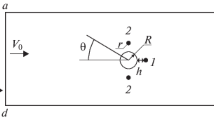Abstract
This paper describes the investigation of a DC surface corona discharge established on a rounded edge of a dielectric material. The ionic wind induced by the discharge was measured with the Particle Image Velocimetry system. A physical induced flow model is proposed to interpret the shape of the velocity field. Experiments on a flat plate and a NACA 0015 were performed in a subsonic wind tunnel. They showed that the flow induced by this discharge acted close to the wall and modified the fully detached flow on the airfoil up to Re = 267,000 and 17.5° by a combined effect of the discharge and a Reynolds effect.













Similar content being viewed by others
References
Anders SG, Sellers WL, Washburn AE (2004) Active flow control activities at NASA Langley, AIAA Paper, 2004-2623
Artana G, DiPrimio G, Desimone G, Moreau E, Touchard G (2001) Electrohydrodynamic actuators on a subsonic air flow around a circular cylinder, AIAA Paper, 2001-3056
Artana G, D’Adamo J, Léger L, Moreau E, Touchard G (2002) Flow control with electrohydrodynamic actuators. AIAA J 40(9):1773–1779
Corke TC, Merts B, Patel MP (2006) Plasma flow control optimized airfoil. AIAA Paper, 2006-1208
Corke TC, Post ML (2005) Overview of plasma flow control: concepts, optimization and applications, AIAA Paper, 2005-0563
Corke TC, He C, Patel MP (2004) Plasma flapts and slats: an application of weakly-ionized plasma actuators, AIAA Paper, 2004-2127
Davidson JH, Shaughnessy EJ (1986) Turbulence generation by electric body forces. Exp Fluids 4:17–26
El-Khabiry S, Colver G (1997) Drag reduction by DC corona discharge along an electrically conductive flat plate for small Reynolds number flows. Phys Fluids 9(3):587–599
Hyun KT, Chun CH (2003) The wake flow control behind a circular cylinder using ion wind. Exp Fluids 35:541–552
Jedrusik M, Galewski JB, Swierczok AJ (2001) Effect of the particle diameter and corona electrode geometry of the particle migration velocity in electrostatic precipitators. J Electrost 51–52:245–251
Jolibois J, Forte M, Moreau E (2006) Separation control along a NACA0015 airfoil using a dielectric barrier discharge actuator. In: IUTAM Symposium on flow control and mems, London (UK) (in press)
Kalman H, Sher E (2001) Enhancement of heat transfer by means of a corona wind created by a wire electrode and confined wings assembly. Appl Therm Eng 21:265–282
Kuroda Y, Kawada Y, Takahashi T, Ehara Y, Ito T, Zukeran A, Kono Y, Yasumoto K (2003) Effect of electrode shape on discharge current and performance with barrier discharge type electrostatic precipitator. J Electrost 57:407–415
Labergue A, Léger L, Moreau E, Touchard G (2005) Effect of a plasma actuator on an airflow along an inclined wall: P.I.V. and wall pressure measurements. J Electrost 63:961–967
Leger L (2003) Contrôle actif d’un écoulement d’air par un plasma froid surfacique, PhD thesis, Université de Poitiers
Leger L, Moreau E, Artana G, Touchard G (2001) Influence of a DC corona discharge on the airflow along an inclined flat plate. J Electrost 51–52:300–306
Leonard GL, Mitchner M, Self SA (1983) An experimental study of the electrohydrodynamic flow in electrostatic precipitators. J Fluid Mech 127:123–140
Louste C, Moreau E, Artana G, Touchard G (2004) Étude de l’action mécanique d’une décharge de surface par mesure PIV et simulation. In: 4th Conférence SFE, Poitiers, pp 174–179
Marco SM, Velkoff HR (1964) Effect of electrostatic fields on free-convection heat transfer from flat plates, American Society of Mechanical Engineers, Paper No 63-HT-9
Mateo-Velez JC, Thivet F, Degond P (2004) Modélisation élémentaire du vent ionique dans une décharge couronne. In: 4th Conférence SFE, Poitiers, pp 180–185
Moreau E (2007) Airflow control by non thermal plasma actuators. J Phys D Appl Phys 40:605–636
Moreau E, Léger L, Touchard G (2006) Effect of a DC surface-corona discharge on a flat plate boundary layer for air flow velocity up to 25 m/s. J Electrost 64(3–4):215–225
Opaits DF, Roupasov DV, Starikovskaia AY, Zavialov IN, Saddoughi SG (2005) Plasma control of boundary layer using low-temperature non equilibrium plasma of gas discharge, AIAA Paper, 2005-1180
Post ML, Corke TC (2003) Separation on high angle of attack airfoil using plasma actuators, AIAA Paper, 2003-1024
Robinson M (1961) Movement of air in the electric wind of a corona discharge. AIEE Trans 80:143–150
Roth JR, Sherman DM, Wilkinson SP (1998) Boundary layer flow control with a one atmosphere uniform glow discharge surface plasma, AIAA Paper 98-0328, 36th Aerospace Sciences Meeting and Exhibit, Reno, NV
Roth JR, Sherman DM, Wilkinson SP (2000) Electrohydrodynamic flow control with a glow-discharge surface plasma. AIAA J 38(7):1166-1172
Roth JR, Sin H, Madhan RCM, Wilkinson SP (2004) Flow re-attachement and acceleration by paraelectric and peristaltic electrohydrodynamic (EHD) effects, AIAA Paper, 2004-0845
Shcherbakov YV, Isanov NS, Baryshev ND, Frolovskij VS, Syssoev VS (2000) Drag reduction by AC streamer corona discharges along a wing-like profile plate, AIAA Paper, 2000-2670
Soldati A, Banerjee S (1998) Turbulence modification by large-scale organized electrohydrodynamic flows. Phys Fluids 10(7):1742–1756
Sosa R, Artana G (2006) Steady control of laminar separation over airfoils with plasma sheet actuators. J Electrost 64(7–9):604–610
Sosa R, Moreau E, Touchard G, Artana G (2004) Stall control at high angle of attack with periodically excited EHD actuators, AIAA Paper, 2004-2738
Velkoff H, Ketcham J (1968) Effect of an electrostatic field on boundary layer transition. AIAA J 16(7):1381–1383
Yamamoto T, Velkoff HR (1981) Electrohydrodynamics in an electrostatic precipitator. J Fluid Mech 108:1–18
Acknowledgments
The authors would like to thank Stéphane Loyer (LME) and Erwan Le Menn (GREMI) for their assistance in setting up these experiments and fixing numerous problems encountered along the way. We would also like to thank Sandrine Aubrun and Régine Weber (LME) for their help during this period.
Author information
Authors and Affiliations
Corresponding author
Rights and permissions
About this article
Cite this article
Magnier, P., Hong, D., Leroy-Chesneau, A. et al. Control of separated flows with the ionic wind generated by a DC corona discharge. Exp Fluids 42, 815–825 (2007). https://doi.org/10.1007/s00348-007-0297-z
Received:
Revised:
Accepted:
Published:
Issue Date:
DOI: https://doi.org/10.1007/s00348-007-0297-z




